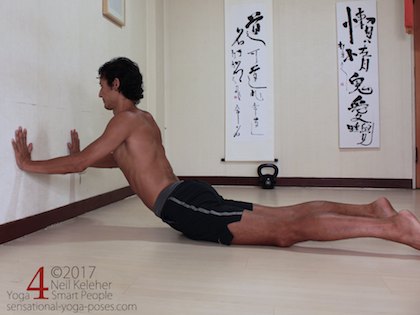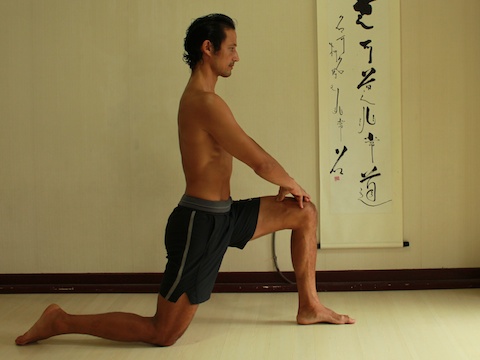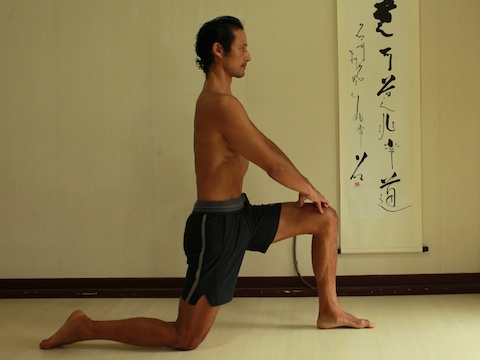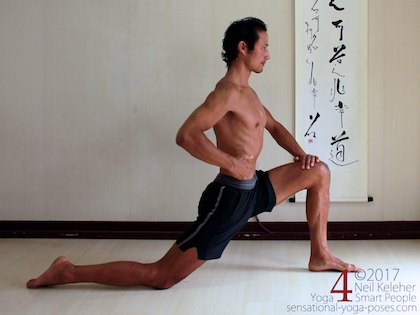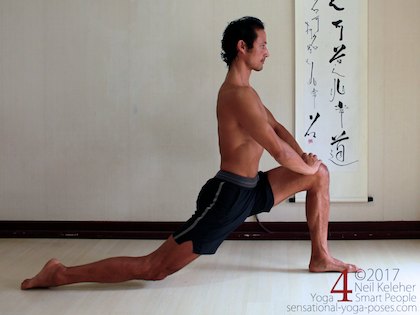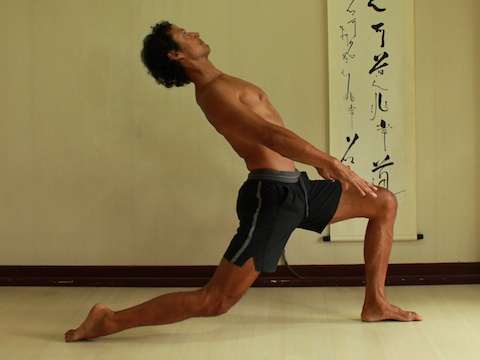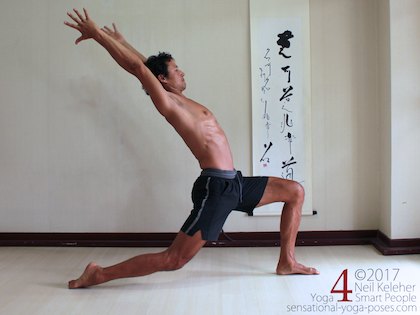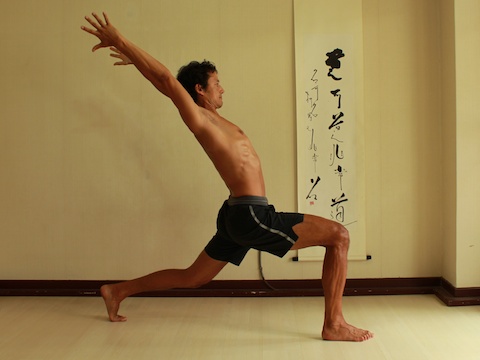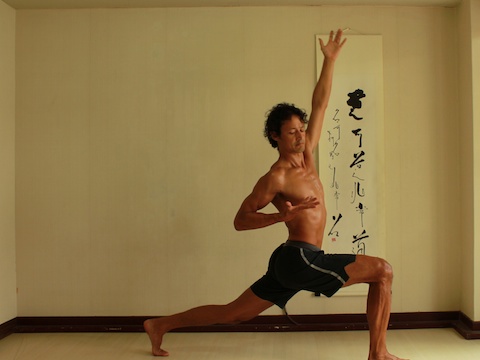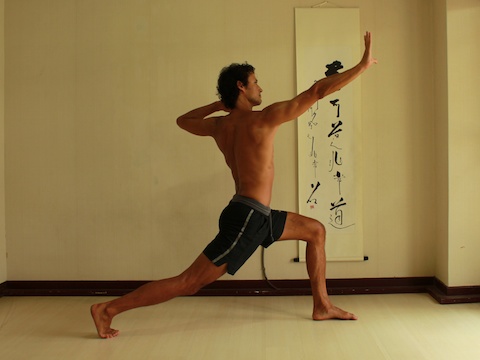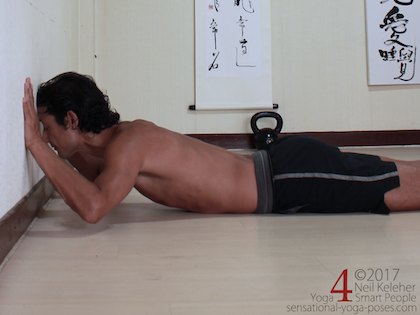Psoas Stretches | Psoas Stretches |
Low Back Pain
I often got a sore back after standing or walking for long periods of time, especially while carrying a back pack or while holding my daughter. And so one of my challenges has been trying to understand the body so that I can make the pain go away.
One of the usual recommendations for countering a tight psoas is to activate the abs. And so I tried this, pulling up on my pubic bone in an attempt to straighten my lumbar spine. It didn't help.
Then I tried using my external obliques, particularly those fascicles (bundles of muscle fibers that attach to a specific point) that attach between the lower ribs and the top of the pelvis.
Lifting my ribcage and then activating my obliques I was presently surprised to experience a reduction in back ache. It's as if activating my obliques signaled my psoas that it was okay to relax.
My first guess was that it is because the psoas and external obliques have a similiar angle and are quite close together in terms of location.
But I also think it's because the external obliques can be used to pull back on the top of the pelvis. And the L5 and L4 lumbar vertebrae are at about the same height as the top of the pelvis. So perhaps by using the obliques to pull back and up on the top of the pelvis lengthens the lower fibers of the psoas while at the same time signalling it that the torso is stable.
In any case, this method works.
I used it while standing still with my weight even on both legs. Then I continued to keep my obliques engaged while walking around. I wasn't carrying a backpack or a baby. (She decided that she wanted to run around.) And it still worked.
The only draw back was that the engagement required seemed quite strong. But it may be that with practice this can be reduced to an optimum level.
At any rate, it has led to a refinement of the high lunge psoas stretch which I talked about in stretching the psoas. Here's the first modified technique.
High Lunge Psoas Stretch With External Obliques Engaged
The starting position for this stretch is with the pelvis over the back knee.
In this position first lift the ribs, then pull back on the iliac crests to activate your external obliques. If you put your hands on the side of your waist you can feel it they are active or not.
Keep your obliques active, keep your torso upright. then increase the bend of your front knee to sink the hips and create a deeper psoas stretch. (Use your hand to check your obliques are still engaged if you can't yet "feel" when they are engaged.)
- Focus on continuing to sink your hips even when your front knee is maximally bent.
- For extra stretch, press the top of your back foot into the floor (or the front of your foot if your toes are tucked under).
- Slowly increase the pressure, using the muscles along the front of your thigh, to the point that your back knee lifts off of the floor. It doesn't have to be straight, just lifted.
- Continue to sink your pelvis down and keeping your knee lifted press back foot into the floor.
Following these steps it is as if the psoas stretches (or is stretched) by keeping the lumbar spine stable (via the external obliques) while moving the thigh back relative to the pelvis.
If you can't feel your obliques engaging, then use your hand to feel if they are engaged.
If you engage them first in the starting position, then move slowly into the stretch you may find it is easier to keep them engaged.
If adding the back knee raise, focus on lifting slowly. Press your foot into the floor first, then increase that pressure to lift the knee. If you find it difficult to keep your knee lifted then lower it while exhaling and lift while inhaling. Make the movement smooth and slow.
Prior to lifting the knee your can lengthen your neck and expand your ribs. Relax both actions as you exhale.
The Psoas Lower Fibers
My low back pain seems to be the result of the lower fibers of my psoas being tight, the fibers that attach to L5 and possible L4. (Psoas muscle includes another type of psoas stretch that targets these lower fibers.) One possible way to release the psoas is to shorten the distance it acts across. And so one day again while my back was aching, instead of trying to lengthen my spine and straighten it in an effort to get rid of back pain, I did the opposite.
If holding an elastic band between your hands, you bring your hands closer together to reduce the tension on the elastic (or perhaps more appropriately in this case, a piece of inflexible string.)
And that's what I did with my psoas. I shortened the distance it acted across by tilting my pelvis forwards while standing. At the same time I allowed the bottom of my lumbar spine to tilt forwards and the upper part of my lumbar spine to tilt back.
And most likely this is why sitting is a release for low back pain. Sitting with thighs horizontal and spine upright, the psoas is no longer near maximum length. It can relax as a result.
An important element, similiar to activating the external obliques, is activating the spinal erectors, to help bend the lumbar spine backwards.
Doing this unifies or integrates the pelvis and spine. The hip stabilizers then stabilize the pelvis and the spine (via those erectors). The psoas can then relax. And even more so because it is no longer in any danger of being stretched while it is already at maximum length.
Muscle "Operating Length"
One thing that can be useful during psoas stretches and other activities that use the psoas is that it and any other muscle has an optimal operational length. This is the length at which they can exert maximum pull.
If a muscles endpoints are to close to each other it can't contract. (That's why I suggest lifting the ribs prior to activating the external obliques.) If they are too far apart then again it may have difficulty in contracting.
Another "principle" for muscle control is that a muscle needs to work against an external force (another muscle) in order to contract.
And yet another, if you want to relax a muscle, make it feel safe, stable.
If you want to make a muscle feel unsafe so that it chronically contracts then make that muscle really long without giving it a stable foundation.
While standing or walking the psoas is maximally long (or nearly so depending on how straight and upright the lumbar spine is). If the hips and/or torso are unstable, unbalanced, while walking, that may cause a chronic contraction of the psoas.
To allow the psoas to relax
- allow it to shorten (tilt pelvis forwards, or bend the knees)
- make the body feel safe, stable (stabilize feet and hips)
Imagine the psoas like a belayer for a mountain climber. If it can see the climber is safe, it can relax. (But it'll still be paying attention so that it's ready to catch that climber if he slips or falls.)
This leads in to the next psoas stretch. Again its a high lunge, but different than before.
High Lunge Psoas Stretch with Spinal Erectors Engaged
Using the same starting positions as before,
- tilt your pelvis forwards.
- Bend the spine back. Use the spinal erectors.
- Contract your abs so that your spinal erectors have something to act against.
- Keep the lumbar spine and thoracic spine bent backwards, tilt the pelvis and spine backwards as one unit.
- Deepen the front knee bent, sink your pelvis.
- Continue to work at tilting your pelvis back.
You can start with your back knee on the floor. Optionally, press the foot into the floor, lift the knee and then work at reaching your back leg back. Make your back leg feel long.
Top of the foot can be on the floor, or tuck your toes under (bottom picture.)
I'm not trying to bend my spine backwards as I hold the pose. I'm trying to tilt my pelvis and spine back together as one unit. But before I do that I pre-bend the spinal column.
Engage your abs after you've bent your spine backwards. The feeling is like you are trying to use your abs to straighten your spine or bend it forwards.
As for the arms, in the first picture above my hands are slightly forwards so that you can see the tilt of my pelvis and the angle between low back and back thigh. You can use this hand position (it actually does feel good) or reach your arms up and back. Or just let them hang straight down.
High Lunging with Style
The psoas attaches to the lumbar spine, but it also has fascia connections to the kidneys, the diaphragm and the lower back ribs. (Read Psoas Major 1 for more information on these connections.)
As such, when doing psoas stretches like high lunge, it helps if you involve your upper body. Lift your ribs away from your pelvis. Lift your shoulders away from your ribs and make your arms feel long. If you make your arms long, you can affect the ribcage which in turn can affect the psoas.
One way to do this is to reach the arms up and back. But another way is to imagine pulling a bow.
I dabble in Tai Ji and because of that I've learned to shape my arms or give them purpose. And that's something you can do in high lunge and also in splits.
But rather than just putting your arms limply in position, this is really only effective if you imagine you are actually pulling a bow (or grabbing someone and throwing them or blocking them.)
Because this is a psoas stretch, I'm aiming my bow up, and I'm holding it in the back leg arm. (Arm on the same side as the back leg.)
When doing yoga poses like this (with style) it's kind of nice to look cool but more important is that it feels good, like you are using your whole body. Find arm positions that feel good to you. For myself I found having the bent elbow up (second picture) felt better than having it down (first picture.) But this might change on any given day.
An Upward Dog Psoas Variation
Depending on how you teach upward dog, (or learn it) it can be easy or hard. One of my intents with using the wall was to find an easy way to use the arms in this pose while at the same time creating a psoas stretch.
It was easier in the swimmingpool where I had a ledge. My face didn't end up being pressed against the wall.
The trick in this psoas stretch is to first activate the spinal erectors to bend the spine backwards. Because you are starting from a laying down position you may not need to activate the abs. Your spinal erectors can work against gravity.
Focus on creating length in your upper body as you bend your spine backwards. Then start to use your arms to push your entire upper body away from the wall.
Push your feet down and lift your knees. Then press the thighs down.
Then use your arms to help push your ribcage up and back.
You can repeat this stretch a few times, moving closer to the wall as your front body opens up.
Related
Psoas Stretches
Reclining Psoas Stretch
Standing Psoas Stretch
Standing Psoas Stretch Variations
Active Psoas Stretches
Published: 2020 08 03
